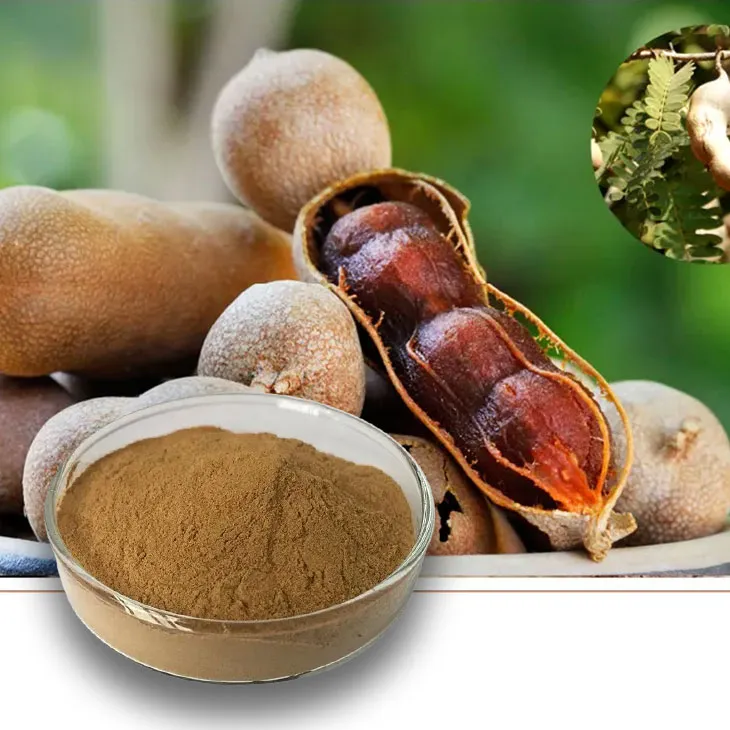- 0086-571-85302990
- sales@greenskybio.com
Is tamarind extract powder beneficial for diabetes? Are these all safe and suitable for diabetic patients?
2024-11-13

1. Introduction
Diabetes is a chronic metabolic disorder that affects millions of people worldwide. Management of diabetes involves lifestyle modifications, including diet, exercise, and in many cases, medications. In recent years, there has been growing interest in the potential benefits of natural products for diabetes management. Tamarind extract powder, derived from the tamarind tree (Tamarindus indica), is one such product that has attracted attention. This article will explore whether Tamarind extract powder is beneficial for diabetes and if it is safe for diabetic patients from various perspectives, including its impact on glycemic control, interaction with medications, and overall health implications.

2. Tamarind extract powder: Composition and Properties
Tamarind extract powder is rich in various bioactive compounds. Some of the key components include polyphenols, flavonoids, and tartaric acid.
2.1 Polyphenols
Polyphenols are known for their antioxidant properties. In the context of diabetes, antioxidants can play a role in reducing oxidative stress, which is often elevated in diabetic patients. Oxidative stress can damage cells and tissues, particularly those in the pancreas (where insulin is produced) and blood vessels. By reducing oxidative stress, polyphenols in tamarind extract powder may potentially help in protecting the function of pancreatic beta - cells and improving endothelial function in blood vessels.
2.2 Flavonoids
Flavonoids are a subclass of polyphenols. They have been shown to have anti - inflammatory effects. Inflammation is also associated with diabetes, especially in the development of insulin resistance. Flavonoids in tamarind extract powder may help in reducing chronic inflammation, thereby potentially improving insulin sensitivity.
2.3 Tartaric Acid
Tartaric acid gives tamarind its characteristic sour taste. While its direct role in diabetes management is not fully understood, it may play a role in digestion and metabolism. Some studies suggest that tartaric acid can influence the absorption of certain nutrients in the gut, which could potentially have an impact on blood sugar levels.

3. Impact on Glycemic Control
One of the most important aspects of diabetes management is glycemic control, which refers to the regulation of blood glucose levels.
3.1 Animal Studies
Several animal studies have investigated the effect of tamarind extract powder on blood sugar levels. In diabetic rats, for example, supplementation with tamarind extract powder has been shown to reduce fasting blood glucose levels. This reduction may be due to the combined effects of its bioactive compounds, such as improved insulin sensitivity and enhanced glucose uptake by cells.
3.2 Human Studies
However, human studies on the effect of tamarind extract powder on glycemic control are relatively limited. Some small - scale studies have suggested a potential beneficial effect on post - prandial (after - meal) blood glucose levels. For instance, in a short - term study involving a small group of pre - diabetic individuals, consumption of tamarind - based products was associated with a mild reduction in post - meal blood sugar spikes. But more large - scale, long - term studies are needed to confirm these findings and establish a clear relationship between tamarind extract powder consumption and glycemic control in humans.

4. Interaction with Diabetes Medications
Many diabetic patients rely on medications to control their blood sugar levels. It is crucial to consider the potential interactions between tamarind extract powder and diabetes medications.
4.1 Hypoglycemic Agents
If tamarind extract powder has a hypoglycemic (blood - sugar - lowering) effect on its own, there is a concern that it could interact with hypoglycemic medications such as sulfonylureas or metformin.
- Combining tamarind extract powder with sulfonylureas, which stimulate the pancreas to secrete more insulin, may increase the risk of hypoglycemia (low blood sugar). This could lead to symptoms such as dizziness, sweating, and confusion.
- With metformin, which works mainly by improving insulin sensitivity and reducing hepatic glucose production, the interaction is less clear. However, there is a possibility that the combined effect could result in an excessive drop in blood sugar levels.
4.2 Other Medications
Diabetic patients may also be taking other medications for related conditions, such as blood pressure - lowering drugs or cholesterol - lowering drugs. There is currently little information on whether tamarind extract powder could interact with these medications. However, given the complexity of the body's metabolic and physiological processes, it is important to be cautious when considering the use of tamarind extract powder in patients taking multiple medications.

5. Overall Health Implications
Tamarind extract powder may have other health implications for diabetic patients beyond glycemic control.
5.1 Cardiovascular Health
As mentioned earlier, the flavonoids and polyphenols in tamarind extract powder have anti - inflammatory and antioxidant properties. These properties can be beneficial for cardiovascular health, which is often compromised in diabetic patients. By reducing inflammation and oxidative stress in blood vessels, tamarind extract powder may help in reducing the risk of atherosclerosis (hardening of the arteries), heart attacks, and strokes.
5.2 Digestive Health
Tartaric acid in tamarind extract powder may play a role in digestive health. It can stimulate the secretion of digestive juices, which may improve digestion. In diabetic patients, good digestive function is important as it can affect the absorption of nutrients and medications. However, excessive consumption of tamarind extract powder may also cause gastrointestinal side effects such as diarrhea or abdominal pain.
5.3 Kidney Health
Some studies suggest that the bioactive compounds in tamarind may have a protective effect on the kidneys. In diabetes, the kidneys are at risk of damage due to high blood sugar levels and increased blood pressure. Tamarind extract powder, through its antioxidant and anti - inflammatory effects, may potentially help in reducing the risk of diabetic nephropathy (kidney disease associated with diabetes).
6. Safety Considerations
While tamarind extract powder may offer potential benefits, safety is also a major concern, especially for diabetic patients.
6.1 Allergic Reactions
Some individuals may be allergic to tamarind. Allergic reactions can range from mild symptoms such as skin rashes and itching to more severe symptoms like difficulty breathing and anaphylactic shock. Diabetic patients who are considering using tamarind extract powder should first be tested for tamarind allergy if they have a history of allergies.
6.2 Contaminants
The quality of tamarind extract powder can vary depending on the source and manufacturing process. There is a risk of contamination with heavy metals, pesticides, or other harmful substances. High - quality, pure tamarind extract powder from a reliable source should be chosen to minimize this risk.
6.3 Dosage
Appropriate dosage is crucial. There is currently no established standard dosage for tamarind extract powder for diabetes management. Excessive consumption may lead to adverse effects, as mentioned above, such as gastrointestinal problems or an increased risk of hypoglycemia in combination with medications. A healthcare provider should be consulted to determine the appropriate dosage based on an individual's overall health status, including their diabetes management and any other comorbidities.
7. Conclusion
Tamarind extract powder contains bioactive compounds that may potentially offer some benefits for diabetes management, such as antioxidant, anti - inflammatory, and possible glycemic - control effects. However, more research, especially large - scale human studies, is needed to confirm these potential benefits. Additionally, safety considerations, including potential interactions with medications, allergic reactions, and contaminants, must be taken into account. Diabetic patients who are interested in using tamarind extract powder should consult their healthcare provider before doing so to ensure that it is safe and appropriate for their individual situation.
FAQ:
Q1: How does tamarind extract powder affect blood sugar levels in diabetic patients?
Tamarind extract powder contains certain compounds that may have an impact on blood sugar levels. Some studies suggest that it might help in regulating blood sugar to a certain extent. It could potentially slow down the absorption of carbohydrates, which in turn may lead to a more gradual rise in blood glucose levels. However, more research is needed to fully understand its exact mechanism and the magnitude of its effect on glycemic control in diabetic patients.
Q2: Can tamarind extract powder interact with diabetes medications?
There is a possibility of interaction between tamarind extract powder and diabetes medications. Since some components in the tamarind extract may have their own effects on blood sugar regulation, when combined with medications such as insulin or oral hypoglycemic agents, it could either enhance or interfere with the action of these drugs. Diabetic patients should consult their healthcare providers before using tamarind extract powder to ensure there are no adverse interactions.
Q3: Is tamarind extract powder safe for long - term use in diabetic patients?
While tamarind has been used in traditional medicine in some cultures, its long - term safety for diabetic patients specifically is not yet fully established. In the short term, it may not cause obvious harm in moderate amounts. But long - term use could potentially have unforeseen effects on various organs and systems related to diabetes management, such as the kidneys or the cardiovascular system. Continuous monitoring and further research are required to determine its long - term safety.
Q4: Are there any side effects of tamarind extract powder for diabetic patients?
Some diabetic patients may experience side effects from using tamarind extract powder. For example, it could cause gastrointestinal discomfort like stomach cramps, diarrhea, or bloating in certain individuals. Additionally, if it has an unexpected impact on blood sugar levels, it could lead to hypoglycemia (low blood sugar) or hyperglycemia (high blood sugar) if not properly monitored. The presence of these side effects may vary from person to person.
Q5: How much tamarind extract powder is suitable for diabetic patients?
There is no established standard amount of tamarind extract powder that is suitable for diabetic patients at present. It depends on various factors such as the individual's overall health, the severity of their diabetes, and their current diet and medication regimen. Starting with a small amount and gradually increasing while closely monitoring blood sugar levels and any potential side effects may be a cautious approach, but it is still advisable to seek medical advice before determining an appropriate amount.
Related literature
- The Potential Role of Tamarind in Health and Disease"
- "Tamarind Extract and its Impact on Metabolic Disorders"
- "Safety and Efficacy of Herbal Supplements in Diabetes Management: A Focus on Tamarind"
- ▶ Hesperidin
- ▶ citrus bioflavonoids
- ▶ plant extract
- ▶ lycopene
- ▶ Diosmin
- ▶ Grape seed extract
- ▶ Sea buckthorn Juice Powder
- ▶ Beetroot powder
- ▶ Hops Extract
- ▶ Artichoke Extract
- ▶ Reishi mushroom extract
- ▶ Astaxanthin
- ▶ Green Tea Extract
- ▶ Curcumin Extract
- ▶ Horse Chestnut Extract
- ▶ Other Problems
- ▶ Boswellia Serrata Extract
- ▶ Resveratrol Extract
- ▶ Marigold Extract
- ▶ Grape Leaf Extract
- ▶ blog3
- ▶ Aminolevulinic acid
- ▶ Cranberry Extract
- ▶ Red Yeast Rice
- ▶ Red Wine Extract
-
Coix Seed Extract
2024-11-13
-
Moringa powder
2024-11-13
-
Motherwort Extract
2024-11-13
-
Mango flavored powder
2024-11-13
-
Resveratrol extract
2024-11-13
-
Garcinia Cambogia Extract
2024-11-13
-
Alfalfa Meal
2024-11-13
-
Genistein
2024-11-13
-
Bitter Melon Extract
2024-11-13
-
Phyllanthus Emblica Extract
2024-11-13





















